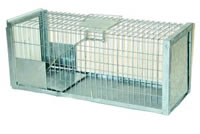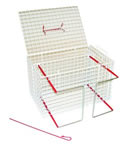Feral cats are the descendants of stray or abandoned domestic cats. If kittens are not handled by people when they are between about four to eight weeks old they will develop a fear of humans. Feral colonies rapidly increase in size and kittens grow up as if they are wild animals and can become completely unapproachable. Uncared for and allowed to breed unchecked, the life of a feral cat is short and miserable and kittens can be born with a range of defects due to inbreeding.
What TVAW does to help
TVAW uses specialist equipment to trap feral cats and kittens.

 |
The humane trap is baited with food. When the cat enters the trap it has to step on a tread plate to reach the food and this
activates a spring which closes the door behind the cat. The cat can then be taken safely and securely to a vet for a health
check and to be neutered.
We sometimes use special baskets called cat restrainers which can be lined up with the door of the trap so that the cat can be easily transferred from the trap to the basket. They are fitted with a movable internal partition - this has running bars attached which extend outside the basket to form handles. The partition is drawn forward until the animal is held gently but firmly against the basket. A vet can then sedate the cat by injection through the side of the basket. This avoids stressing the cat by trying to handle it and also avoids injury to all concerned. Once the cat has received whatever treatment is necessary as well as being wormed, defleaed and neutered it will be released into one of our cat houses to await a new home. |
Occasionally feral cats can be returned to site if there is suitable shelter and someone responsible for feeding the cats and looking after their general welfare. However, it is more usual for the cats to have to be removed in which case we look for homes for the cats at stables, farms and small holdings. We expect the new owner to have somewhere warm and sheltered such as a stable or barn where the cats can sleep, and to provide food and water twice a day. Although some people expect feral cats to live on what they can catch, a cat will hunt much more effectively if it is well fed. As feral cats are often used to living in a colony we always try to rehome them in pairs.
We provide the new owner with a collapsible pen for the cats to live in while they are becoming used to their new home. After two to three weeks the cats can be let out and should stay in the vicinity of the stable or barn. Once they have settled the pen can be removed.
If we trap young kittens, up to about 12 weeks old, one of our volunteer socialisers will have the kittens in their home. The kittens start off in a collapsible pen with space for their bed, litter tray and food. The kittens are handled as much as possible to try to overcome their fear of people and get used to the sights and sounds of a busy household. It usually takes a few weeks but eventually most of these kittens will be able to be rehomed as domestic pets.
Example timetable for the development of a feral colony:
| May | A litter of kittens is born. |
| July | 1 female kitten is rehomed by the owners, aged 8 weeks. |
| November | The kitten is old enough to be spayed but the owner fails to do so. |
| February | The kitten is 9 months old and comes into season. She is chased by local toms until they have mated with her several times. Now she is far away from home and cannot find her way back. |
| May | If she is lucky she will have been found by someone who will care for her or contact an animal charity. If not, still a kitten herself, she will have her kittens under a garden shed or in a hedge bottom. She will be desperate to find food but people who don't want to be pestered will chase her away. Gradually she will learn to fear people and she will teach her kittens to fear people. |
| July | The mother cat will come into season and will be mated again. She will have another litter of kittens. |
| September | By this time the kittens from the first litter could be mating and having kittens themselves. |
In this hypothetical case the unspayed female disappears in February; has her first litter in May and is having another litter by September. In less than twelve months this colony could easily grow from one unneutered cat to between 20 and 30 unneutered cats and will keep on growing until either disease or starvation takes its toll.
If the first little colony of mum and kittens could be helped quickly the kittens could all be socialised and rehomed as domestics and even the mother cat could be rehabilitated and rehomed.

